French Normandy is edged with bold stone cliffs, inviting pebble shores and broad sandy beaches. Parisians have long escaped their urban surroundings to enjoy respite in this land along La Manche, the English Channel, just a few hours from the capital.
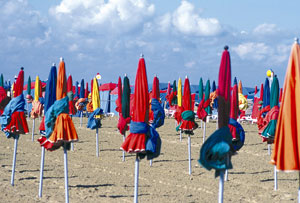 Saturday is market day in the old fishing town of Honfleur. The boat-filled “Old Harbor” is lined with tall and narrow 18th-century slate-roofed townhouses along the quay, creating a townscape considered to be one of the most picturesque in all of Normandy.
Saturday is market day in the old fishing town of Honfleur. The boat-filled “Old Harbor” is lined with tall and narrow 18th-century slate-roofed townhouses along the quay, creating a townscape considered to be one of the most picturesque in all of Normandy.
Here wives of fishermen sell the day’s catch, including crevettes grises, the locally famous tiny sweet Honfleur shrimp. Further on, outdoor market vendors offer innumerable varieties of artisanal cheeses and homemade fresh and dried sausages, little quails plucked naked but for their little feathered heads, huge rounds of farmer’s bread, wild mushrooms, forest strawberries and all the famous Normandy apples anyone could ever need.
As it begins to drizzle, weekend visitors prowl the shops and galleries cued to the town’s tourist and gentry clientele. They drop in at Gribouille, a shop overflowing with favorite regional specialties of food and drink, for tastings of calvados, the renowned distilled apple spirits of this part of Normandy, and pommeau, a blend of calvados and apple juice.
La Côte Fleurie, the Flower Coast, starts here at Honfleur and stretches along the channel to the west. When Napoleon III and Empress Eugénie began to bring their court to Trouville in the 1860s, the aristocracy eagerly followed.
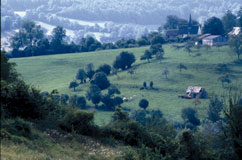 The emperor’s cousin, the Duc de Morny, and his company settled in at adjacent Deauville, where he built a race track, and where this summer society indulged in the newly fashionable pleasures of sea bathing and taking the salt air between their chic dinner-dance parties.
The emperor’s cousin, the Duc de Morny, and his company settled in at adjacent Deauville, where he built a race track, and where this summer society indulged in the newly fashionable pleasures of sea bathing and taking the salt air between their chic dinner-dance parties.
In the early 1900s a casino was added to the entertaining mix, and the new and grand Hotel Normandy began catering to those elegant visitors who found themselves “homeless,” so to speak, in that resort town replete with luxurious villas.
Deauville is still so popular with folks from the capital, it is often called “the 21st arrondissement of Paris.” On summer mornings life starts slowly and quietly along Les Planches, the 500-meter-long boardwalk along the beach.
At Bar du Soleil people settle in for petit dejeuner and some people-watching, said to be the favorite activity in Deauville. Dogs of obvious pedigree are taken for leisurely walks by well-padded captains of industry.
A buff jogger burns up the boards in the crisp air. He then reverses any health benefits by pausing for a cigarette against the railings inscribed with the names of film stars honored by the town’s annual American Film Festival.
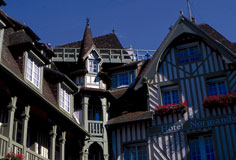 As two horseback riders gallop down the distant shore, a young bare-faced beauty passes by with her small boy in tow. Could it really be that Hollywood icon without her usual glitz?
As two horseback riders gallop down the distant shore, a young bare-faced beauty passes by with her small boy in tow. Could it really be that Hollywood icon without her usual glitz?
As far as the eye can see, the broad expanse of sand, perfectly groomed by vehicle-drawn rakes, is dotted with hundreds of closed and bound parasols of brilliant colors. As the sun rises a bit higher, one by one they are unfurled by beach attendants for the renters who begin to settle in for a day in the sun or shade.
Whatever the activities—reading, building sand castles, dozing—they tend to center on the beach, for even in summer the channel waters remain quite chilly. The morning sky is blue, and the clouds fluffy but, as they say in this well-watered region, if you can see the port city of Le Havre across the bay from Deauville, it hasn’t started raining yet, and if you can’t, it is already raining.
A drive up the coast beyond Le Havre leads to the wild and wonderful sheer limestone cliffs at Étretat, a place that has drawn French landscape painters and writers for more than a century.
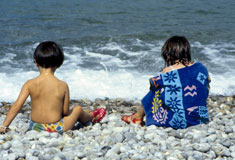 Carved by wind and sea, the rock formations frame the small, pretty village fronted by a pebble beach. Steep trails climbing to green headlands above the sea on the west lead to a dramatically situated golf course and, on the east to the 19th-century Chapel of Notre Dame, dedicated to the safety of the sailors who set out from this coast.
Carved by wind and sea, the rock formations frame the small, pretty village fronted by a pebble beach. Steep trails climbing to green headlands above the sea on the west lead to a dramatically situated golf course and, on the east to the 19th-century Chapel of Notre Dame, dedicated to the safety of the sailors who set out from this coast.
Here at Étretat, an “oyster park” was once dug for Marie Antoinette to indulge her great love for this shellfish. Live oysters were brought in by sloop and re-submerged in that spot where salt water from the sea mixed with fresh water from an underground river. There, over a period of several months, they would develop a particularly delicate flavor before being harvested and rushed off to Paris on horseback.
The freshest seafoods are still an irresistible attraction of these shores. Traditional Norman recipes make great use of the region’s three major products—seafood, dairy products and apples—separately or in delicious and unique combinations. While the appealing landscapes and waterscapes of Normandy prove to be enjoyable as well as memorable, its distinctive cuisine will not be easily forgotten either.
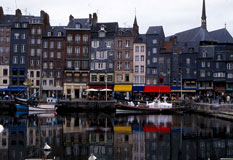 GETTING THERE
GETTING THERE
Air France flies daily from Narita to Paris. SNCF trains reach points in Normandy from the Paris station Gare St-Lazare.
WHERE TO STAY
In its nearly century-long past, the Hotel Normandy (Now the Normandy Barriere, of the Lucien Barriere Hotels & Casinos) has played host to the rich and famous of France and the world, along with more ordinary folks who enjoy luxurious comfort with a sense of the past.
It has been used as a location in more than 20 films, including Claude Lelouch’s renowned film of the ’60s, “A Man and a Woman.” With its elegant public spaces and rooms decorated in plush French country style, it remains without a doubt, the ultimate place to stay in Deauville.
Web: www.lucienbarriere.com




